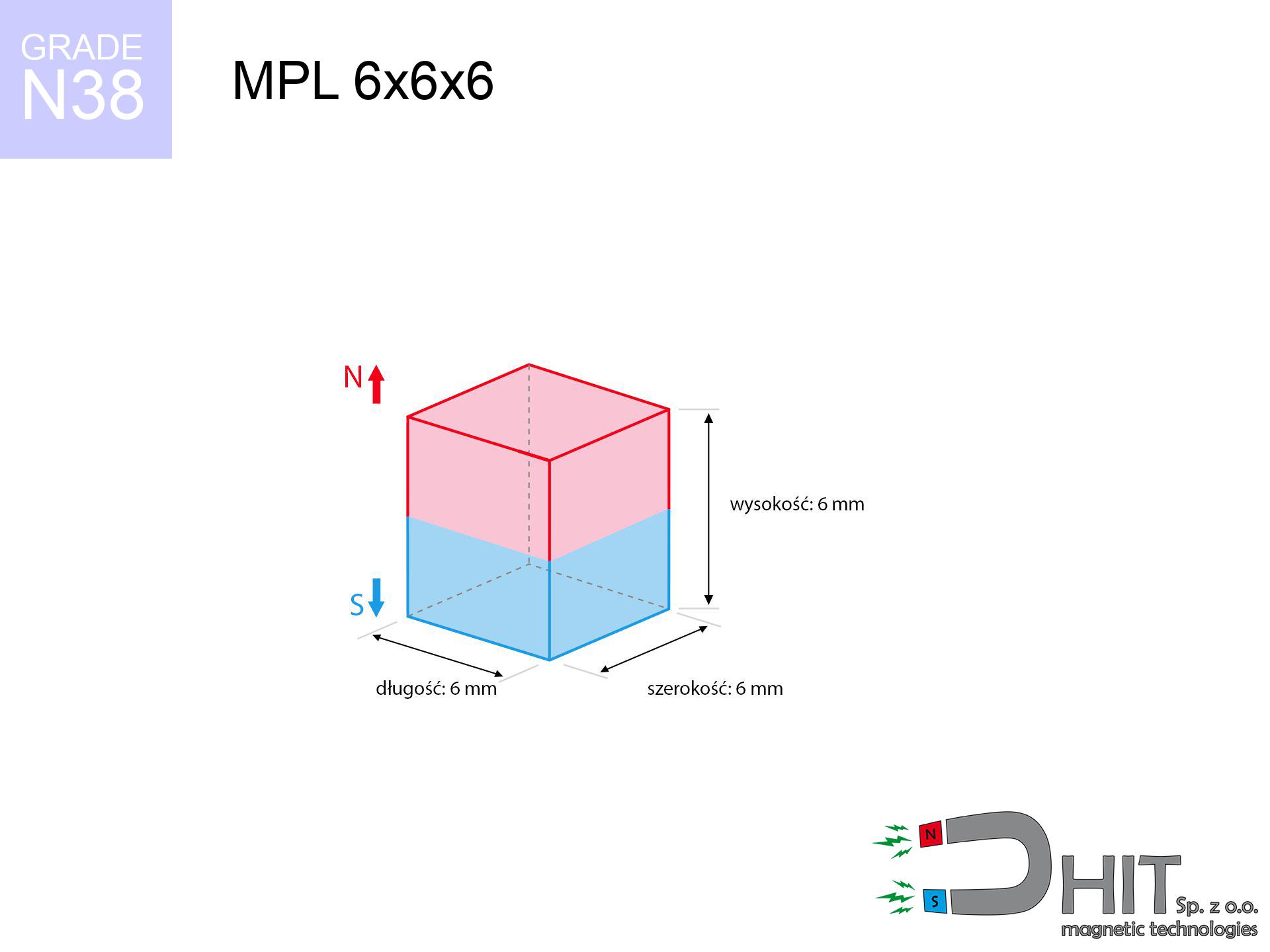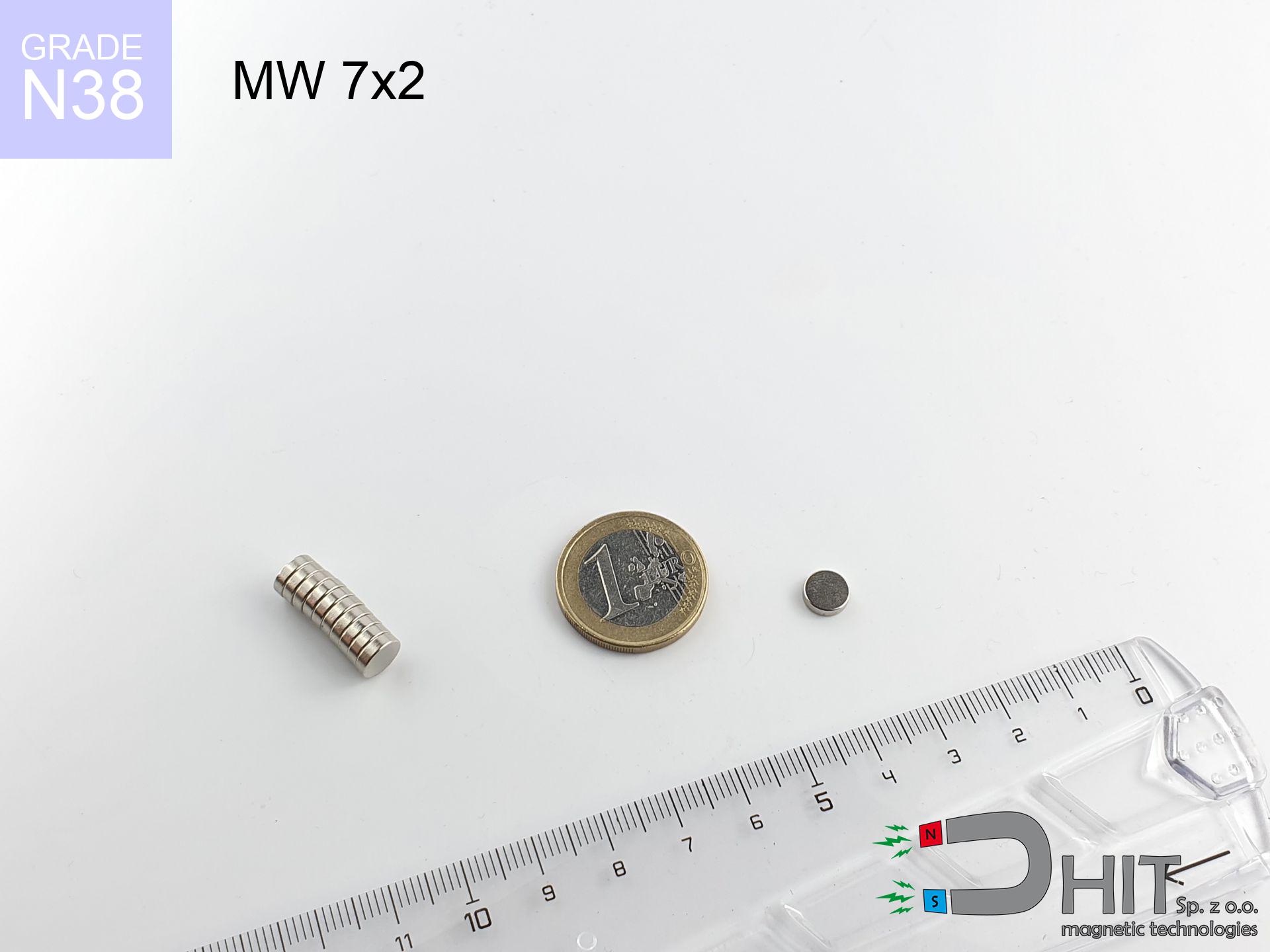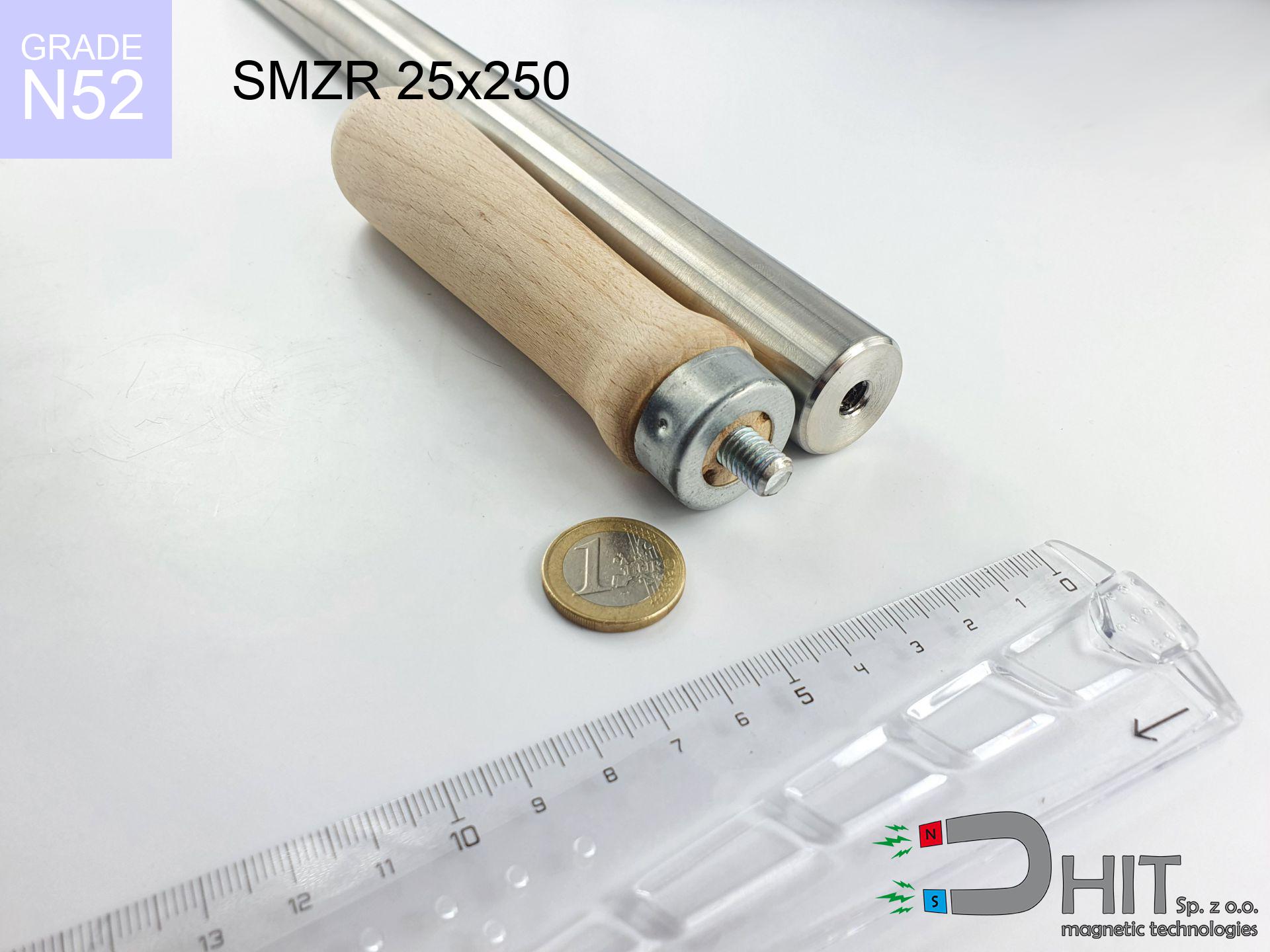MPL 6x6x6 / N38 - lamellar magnet
lamellar magnet
Catalog no 020175
GTIN: 5906301811817
length [±0,1 mm]
6 mm
Width [±0,1 mm]
6 mm
Height [±0,1 mm]
6 mm
Weight
1.62 g
Magnetization Direction
↑ axial
Load capacity
2.84 kg / 27.85 N
Magnetic Induction
539.50 mT
Coating
[NiCuNi] nickel
0.898 ZŁ with VAT / pcs + price for transport
0.730 ZŁ net + 23% VAT / pcs
bulk discounts:
Need more?Can't decide what to choose?
Pick up the phone and ask
+48 888 99 98 98
otherwise send us a note through
our online form
the contact page.
Strength as well as shape of neodymium magnets can be analyzed using our
magnetic mass calculator.
Orders submitted before 14:00 will be dispatched today!
MPL 6x6x6 / N38 - lamellar magnet
Magnetic properties of material N38
Physical properties of NdFeB
Shopping tips
Thanks to their high strength, flat magnets are frequently applied in structures that require strong holding power.
Typical temperature resistance of these magnets is 80 °C, but with larger dimensions, this value grows.
Additionally, flat magnets usually have special coatings applied to their surfaces, e.g. nickel, gold, or chrome, for enhancing their durability.
The magnet named MPL 6x6x6 / N38 i.e. a magnetic force 2.84 kg which weighs a mere 1.62 grams, making it the ideal choice for projects needing a flat magnet.
Contact surface: Due to their flat shape, flat magnets ensure a greater contact surface with other components, which is beneficial in applications requiring a stronger magnetic connection.
Technology applications: These magnets are often applied in many devices, such as sensors, stepper motors, or speakers, where the flat shape is necessary for their operation.
Mounting: The flat form's flat shape simplifies mounting, especially when it is required to attach the magnet to some surface.
Design flexibility: The flat shape of the magnets permits creators a lot of flexibility in placing them in devices, which can be more difficult with magnets of more complex shapes.
Stability: In certain applications, the flat base of the flat magnet may provide better stability, minimizing the risk of shifting or rotating. However, one should remember that the optimal shape of the magnet depends on the specific application and requirements. In some cases, other shapes, like cylindrical or spherical, are more appropriate.
Magnets have two main poles: north (N) and south (S), which attract each other when they are different. Similar poles, e.g. two north poles, repel each other.
Thanks to this principle of operation, magnets are regularly used in electrical devices, e.g. motors, speakers, sensors, or magnetic locks. Neodymium magnets stand out with the highest power of attraction, making them ideal for applications requiring strong magnetic fields. Additionally, the strength of a magnet depends on its dimensions and the material it is made of.
It’s worth noting that extremely high temperatures, above the Curie point, cause a loss of magnetic properties in the magnet. Every magnetic material has its Curie point, meaning that once this temperature is exceeded, the magnet stops being magnetic. Additionally, strong magnets can interfere with the operation of devices, such as compasses, credit cards and even electronic devices sensitive to magnetic fields. Therefore, it is important to avoid placing magnets near such devices.
Advantages and disadvantages of neodymium magnets NdFeB.
Apart from their strong magnetic energy, neodymium magnets have these key benefits:
- They retain their magnetic properties for around ten years – the loss is just ~1% (in theory),
- They are very resistant to demagnetization caused by external field interference,
- The use of a decorative nickel surface provides a eye-catching finish,
- The outer field strength of the magnet shows remarkable magnetic properties,
- Neodymium magnets are known for very high magnetic induction and the ability to work at temperatures up to 230°C or higher (depending on the geometry),
- With the option for fine forming and personalized design, these magnets can be produced in various shapes and sizes, greatly improving design adaptation,
- Key role in new technology industries – they serve a purpose in computer drives, electromechanical systems, clinical machines or even sophisticated instruments,
- Relatively small size with high magnetic force – neodymium magnets offer impressive pulling strength in small dimensions, which makes them ideal in small systems
Disadvantages of NdFeB magnets:
- They can break when subjected to a heavy impact. If the magnets are exposed to physical collisions, they should be placed in a metal holder. The steel housing, in the form of a holder, protects the magnet from cracks , and at the same time increases its overall strength,
- Magnets lose power when exposed to temperatures exceeding 80°C. In most cases, this leads to irreversible performance loss (influenced by the magnet’s profile). To address this, we provide [AH] models with superior thermal resistance, able to operate even at 230°C or more,
- Magnets exposed to damp air can corrode. Therefore, for outdoor applications, we recommend waterproof types made of non-metallic composites,
- Using a cover – such as a magnetic holder – is advised due to the limitations in manufacturing threads directly in the magnet,
- Possible threat from tiny pieces may arise, in case of ingestion, which is notable in the protection of children. Moreover, minuscule fragments from these assemblies have the potential to hinder health screening if inside the body,
- In cases of tight budgets, neodymium magnet cost may be a barrier,
Maximum lifting capacity of the magnet – what affects it?
The given holding capacity of the magnet corresponds to the highest holding force, calculated in the best circumstances, namely:
- with mild steel, used as a magnetic flux conductor
- of a thickness of at least 10 mm
- with a smooth surface
- with no separation
- under perpendicular detachment force
- at room temperature
Determinants of practical lifting force of a magnet
Practical lifting force is dependent on factors, by priority:
- Air gap between the magnet and the plate, because even a very small distance (e.g. 0.5 mm) can cause a drop in lifting force of up to 50%.
- Direction of applied force, because the maximum lifting capacity is achieved under perpendicular application. The force required to slide the magnet along the plate is usually several times lower.
- Thickness of the plate, as a plate that is too thin causes part of the magnetic flux not to be used and to remain wasted in the air.
- Material of the plate, because higher carbon content lowers holding force, while higher iron content increases it. The best choice is steel with high magnetic permeability and high saturation induction.
- Surface of the plate, because the more smooth and polished it is, the better the contact and consequently the greater the magnetic saturation.
- Operating temperature, since all permanent magnets have a negative temperature coefficient. This means that at high temperatures they are weaker, while at sub-zero temperatures they become slightly stronger.
* Holding force was tested on a smooth steel plate of 20 mm thickness, when a perpendicular force was applied, however under shearing force the lifting capacity is smaller. Moreover, even a slight gap {between} the magnet’s surface and the plate decreases the load capacity.
Handle Neodymium Magnets with Caution
Maintain neodymium magnets far from youngest children.
Neodymium magnets are not toys. You cannot allow them to become toys for children. In such a situation, surgery is necessary to remove them. In the worst case scenario, it can result in death.
Dust and powder from neodymium magnets are flammable.
Avoid drilling or mechanical processing of neodymium magnets. If the magnet is crushed into fine powder or dust, it becomes highly flammable.
Neodymium magnets can demagnetize at high temperatures.
Under specific conditions, Neodymium magnets can lose their magnetism when subjected to high temperatures.
Neodymium magnets are the strongest magnets ever created, and their strength can shock you.
To use magnets properly, it is best to familiarize yourself with our information beforehand. This will help you avoid significant harm to your body and the magnets themselves.
Do not place neodymium magnets near a computer HDD, TV, and wallet.
Neodymium magnets generate intense magnetic fields that can destroy magnetic media such as floppy disks, video tapes, HDDs, credit cards, magnetic ID cards, cassette tapes, or other devices. They can also destroy videos, televisions, CRT computer monitors. Do not forget to keep neodymium magnets away from these electronic devices.
The magnet is coated with nickel - be careful if you have an allergy.
Studies clearly indicate a small percentage of people who suffer from metal allergies such as nickel. An allergic reaction often manifests as skin redness and rash. If you have a nickel allergy, you can try wearing gloves or simply avoid direct contact with nickel-plated neodymium magnets.
Avoid bringing neodymium magnets close to a phone or GPS.
Magnetic fields generated by neodymium magnets interfere with compasses and magnetometers used in navigation, as well as internal compasses of smartphones and GPS devices.
Magnets made of neodymium are known for being fragile, which can cause them to become damaged.
Neodymium magnets are extremely fragile, and by joining them in an uncontrolled manner, they will break. Neodymium magnets are made of metal and coated with a shiny nickel surface, but they are not as hard as steel. At the moment of connection between the magnets, small metal fragments can be dispersed in different directions.
Neodymium magnets are not recommended for people with pacemakers.
In the case of neodymium magnets, there is a strong magnetic field. As a result, it interferes with the operation of a heart pacemaker. However, if the magnetic field does not affect the device, it can damage its components or deactivate the device when it is in a magnetic field.
Neodymium magnets can attract to each other, pinch the skin, and cause significant swellings.
If joining of neodymium magnets is not under control, then they may crumble and also crack. You can't approach them to each other. At a distance less than 10 cm you should have them very firmly.
Safety precautions!
So that know how powerful neodymium magnets are and why they are so dangerous, read the article - Dangerous powerful neodymium magnets.




![UMP 75x25 [M10x3] GW F200 GOLD DUAL / N42 - search holder UMP 75x25 [M10x3] GW F200 GOLD DUAL / N42 - search holder](https://cdn3.dhit.pl/graphics/products/ump-75x25-m10x3-gw-f200-gold-dual-xoc.jpg)
![SM 25x225 [2xM8] / N52 - magnetic separator SM 25x225 [2xM8] / N52 - magnetic separator](https://cdn3.dhit.pl/graphics/products/sm-25x225-2xm8-lod.jpg)



